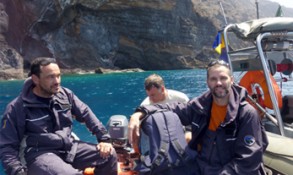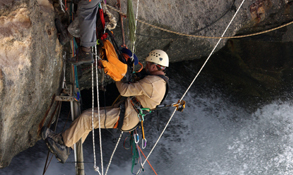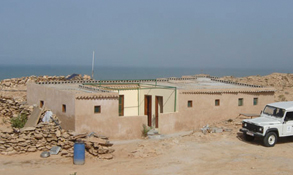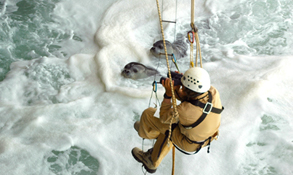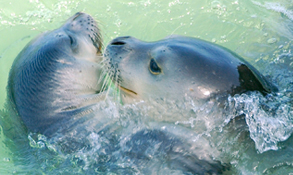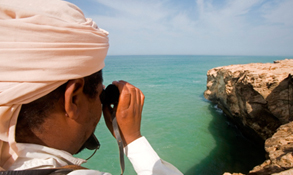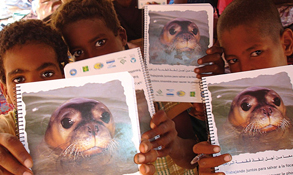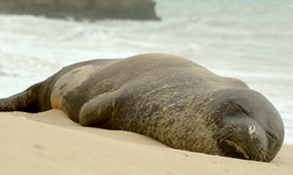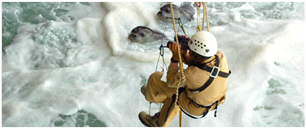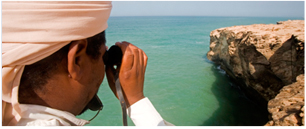Latest entries in our blog
On Friday, April 12, we received a call from Madeira, where we are carrying out a LIFE project with the Mediterranean monk seal. In that archipelago we had only seen them in Madeira and Desertas, but that Friday a seal had appeared in another of…
Here the link to the article recently appeared in El País Semanal, signed by José Naranjo and that summarizes and updates the information of the monk seal colony in Cabo Blanco. https://elpais.com/elpais/2019/02/11/eps/1549900482_069858.html?id_externo_rsoc=FB_CC
On December 26, a new maximum was broken in the periodic counts of individuals that we do every week in each breeding cave. There were no fewer than 149 individuals together on the beach inside the Cave 3. Adding the samples counted in the other…
Our Greek colleagues invited us to participate in a LIFE project that takes place in Andros, the northernmost island of the Cyclades. Due to its proximity to Evia, it is a connecting link between the Cyclades and the islands of the western Aegean, a fact…
On Friday, May 11, the first exhibition about the species in Spain entitled “The Return of the Monk Seal” was inaugurated at the Faunia facilities, in order to raise awareness and make known to the general public about the monk seal of the Mediterranean. We…
AIZA, the Iberian Association of Zoos and Aquariums, has granted us this year, in the category of “Projects of Conservation and Investigation in situ 2018″ its annual prize. It is very good news for all of us, because they have rewarded our work in Madeira,…
Footage of the action “Protection of caves of interest used by monk seals using photo tramp cameras”. LIFE13NAT/ES/000974 Life Madeira Monk Seal.
The LIFE IP INTEMARES, is the largest project of conservation of the marine environment in Europe. It aims to achieve a consolidated network of marine areas of the Natura 2000 Network, managed efficiently, with the active participation of the sectors involved and with research as…
A few years ago, we baptized with the name of Jean Paul Taris cave 7, in honor of one of the people who most believed and supported our project from the MAVA Foundation, and who died in 2015. Recently we have received the visit of…
Cabo Blanco peninsula is located in the middle of the Western coast of the Sahara desert. The colony is on its west side, in a stretch with cliffs over 10 m high, at the base of which are the marine caves that seals use, facing…
Conservation agents clean the reserve every month. The garbage removed is mostly plastic and traces of fishing nets, very dangerous for seals. Large amounts of waste accumulate on the beaches where seals eventually come to rest, so this work is maintained over time, and is…
In order to identify the marine habitat used by the monk seal of the population of Madeira, a non-invasive tagging device with Fastloc GPS receivers and a system for receiving information has been developed technically. This non-invasive methodology, without the need to capture, immobilize or…
As every morning, on Monday august 15th we turned on the camera that allow us to monitor from the distance, the daily going of the seals of the reserve “Costa de las Focas” at the inside of the breeding caves. We thought it would be…
Today, July 21, 2016, we have lost one of the people who has worked hardest towards the conservation of nature around the world, Mr. Luc Hoffmann. Founder of the World Wildlife Fund, a pioneer in the preservation of the Doñana wetlands and the father of…
23 pups were born so far at “Costa de las Focas” reserve. It could seem just a number, nothing to be proud of…but the truth is that it means an incredible success. 23 pups and we are just starting the 6th month of 2016! We…
José Antonio Valverde says on its memories, “Memories of a heterodox biologist”, that it was quite frequent to see mixed groups of mhorr gazelle (Nanger dama mhorr) and Dorcas gazelle (Gazella dorcas neglecta) sharing the same resources on the 50s and 60s at the former…
What has in common something as prosaic as electricity, with the protection of one of most endangered marine species of the world? Probably not much, except for the fact that with this blog we want to show as accurate as possible the conditions in which…
Sahara is a female catalogued with the ID number 2145. Her first observation was on 1995 as an adult/subadult. She should be around 23 years of age. She gave birth to at least 10 pups, of which 9 survived to first molt. This means that…
Our team works since 20 years ago, although with different acronyms, for the protection of the Mediterranean monk seal at Cabo Blanco peninsula. And if there is something that we learned is that the protection of seals or any other endangered species, cannot be understood…
The birth of P805 on march of this year, was the starting point of the 2015 breeding season. One season that we hoped it would give us a new record regarding the number of pups born. And it happened that way!! 73 pups were born…
This adult male is very especial for us. Monitored since birth, the actual 2384 was named one eyed, because when pup, he lost one of his eyes. Born on October 2009, he was very easy to detect because of his distinguishable wound. Constantly monitored ever…
21 years went by since the placing of the first camera of video-surveillance on the entrance of cave 1. A pioneer event that allowed discovering the intimacy of the seals inside their cavernous home, where they haul out and breed. A very discreet method that…
If something have in common the Mediterranean monk seal (Monachus monachus) and the Galapagos sea lion (Zalophus wollebaeki) is that there are ones of the only pinnipeds that inhabit tropical areas, as the Galapagos fur seal (Arctocephalus galapagoensis) and the Hawaiian monk seal (Neomonachus schauinslandi).…
Since 20 years ago, Cabo Blanco seals have been monitored continuous and intensely. Throughout this time, the knowledge we have of the colony is higher than of any other Mediterranean monk seal population. We think that for the first time we are looking at a…
Two months already went by after the release of the “mohor” at Safia Even if it is too soon to analyze the behavior of this antelope in the wild, we cannot help to take a look to what one of the females radio-tagged did. Well,…
Every year thanks to the photoidentification and the monitoring of the inside of the main breeding caves, we are able to detect how many subadults and adults are, as well as how many pups or youngsters survive. Today, “Costa de las Focas” reserve has a…
Amrigue is a very special seal. He is now the most well-known adult male of the colony that inhabits “Costa de las Focas” reserve, and it is so because he decided to live at the Satellite Reserve of Cabo Blanco, the only area open to…
At the post of May 25th, we told you how were the breeding caves of Cabo Blanco monitored, using surveillance cameras, with which a very precise, continuous and in real time monitoring of the colony is achieved. However this methodology can only be used at…
We told you already that during the month of May was performed the second “Operación Mohor” with the release- at the region of Safia- of the first individuals of this beautiful antelope extinct in the wild at the end of the 60s . After being…
In memory of Mar Cano This time we won’t talk about seals. The woman of the picture is Teresa Abáigar. The beautiful animal that she is cuddling with such dedication is a Mohor antelope (Nanger dama mhorr). She is a researcher at the CSIC (Higher…
The century begins for us with two celebrations to highlight. On one hand, there are more monk seals breeding at the colonies of Cabo Blanco and Madeira in the Atlantic. An encouraging result that had its origin in the proposal, in 1999, of Luis Mariano…
The population of monk seals that inhabits the “Costa de las focas” reserve is unique. Unique because if represents close to half of the entire population of the species worldwide; unique because it is the largest colony that exists to date; unique because it keeps…
Originally there were 3 different monk seal species in the world, very further apart geographically speaking. One of them, the Caribbean monk seal (Neomonachus tropicalis), went extinct by mid-XX century. Today, the Hawaiian monk seal (Neomonachus schauinslandi) and the Mediterranean monk seal (Monachus monachus), still…
We talked before on this same blog about the Dorcas gazelle and how it shared the habitat with the monk seal. We never get tired on insisting about the vulnerable situation in which this species is. Even more if we think about the luck that…
If anything has characterized the twentieth century, it was undoubtedly its bellicosity and destructive power. Two world wars and countless conflicts, civil, regional, genocide, arms races, blocs and alliances, bombs of mass destruction, nuclear era, dictatorship, famine, social inequalities, massive population displacement, persecution, refugees, and…
A conservation program is not completed if it does not include awareness campaigns with which rise concern to local population about the problem faced and mostly important if it does not make them part of the solution. Or at least this is what the Mediterranean…
The Mediterranean monk seal is a critically endangered species. Searching a medical simile it would be something like a patient diagnosed to be very ill, needing to stay with its vital signs and other biological parameters constantly monitored. Any alteration, any malfunction in its vital…
This is a recognition to the teams that work in the field. Many times we think that the people that have the opportunity to work every day at “Costa de las Focas” reserve and at the expansion area of the colony located up north, are…
P805. That is the brand new number with which we are starting the 2015 breeding season. A breeding season that has started over a month earlier than the last ones. In fact it has been a very long time since “Costa de las Focas” reserve…
The history of the monk seal colony of Cabo Blanco is very related to fishery activity. Western Sahara coast represents one of the most productive fishing grounds of the world. Fisheries is one of the main economic activities in Mauritania. Negative interaction with fishing gears…
On January 2015 we wrote a post on this same blog presenting the tagging of monk seal individuals at Cabo Blanco using GPS-Fasloc tags and its importance for the protection of the species. Now we want to tell you how it has been achieved. The…
Could you imagine being able to see a monk seal and a gazelle almost at the same time? This luck have the conservation agents that go across the coastal area located north of the monk seal colony. It is frequent, during those itineraries of the…
Part of the monitoring being performed at the 144km north coast of the reserve is being done with photo trap cameras. Their mission is to test strategic areas, caves and beaches, of the coast and detect their use by seals. During 2014, 8 cameras have…
At the end of November 2014, we wrote a post at this same blog about the new app we were going to include on the surveillance of “Costa de las Focas” reserve. Not too long afterwards, on December 2014, conservation agents started to test on…
The Mediterranean monk seal is a marine animal and the most part of its life cycle happens at sea. It seems an obvious statement, doesn’t it? Even so, until not too long ago, the marine habitat of interest for these seals was completely unknown: it…
As the result of the efforts made under the frame of the project funded by Lifeweb Initiative (UNEP) for the strengthening of the protected marine areas at the “Special Areas of Conservation for the Monk Seal (SACMS)”, authorities of the region have reinforce the surveillance…
With the 2014 breeding season closed, we can do the review. As it has been told at these same blog pages, a new record of births has been achieved at the colony. 69 in total. To say more, this year the survival rate before the…
This year that is about to end, has left us with a lot of good news and great achievements towards the recovery of the species at “Costa de las focas” reserve. But before highlighting some of them, it is very important for us to emphasize…
Mediterranean monk seals use at Cabo Blanco a coastal line composed, mainly, of cliffs and littoral caves, constantly exposed to the swell and tide action of the Atlantic ocean. In fact, as most of you would probably know, individuals of the colony always reproduce and…
On December 9th and 10th we participated at the seminar “LESSONS LEARNED FROM THE 2010-2014 SPAIN/UNEP PARTNERSHIP FOR PROTECTED AREAS IN SUPPORT OF LIFEWEB” at Nairobi. Results of the different projects developed under the LIFE WEB initiative were presented. In our case we gave a…
“Costa de las Focas” reserve protects 6 km of coastal area where are the breeding caves use by the seals to breed and haul out. When the Mediterranean monk seal conservation program started close to 15 years ago, there were only being used two caves…
“Costa de las Focas” reserve, was created on 2001 for protecting the Mediterranean monk seal colony that lived there, but it seems than many more species are benefit from this protection. One of them is the desert fox: a group of this species has decided…
The second week of November, technicians of CBD-Habitat foundation had received a course about geographical information system and about how to program Cybertracker software. Cybertracker is a free software that turns to be the most efficient method to register information bound to GPS position, on…
The coast in which the breeding caves are located is formed by beaches and cliffs. Cliffs are very fragile and the collapses are a great threat for the species. What a surprise had the conservation agents that work at the north of the reserve…
Sometimes, when looking inside the breeding caves at “Costa de las Focas” reserve, technicians see incredible behaviors, like, if even rare to see, two pups feeding on milk from the same female. Observing this type of behavior, you may get the conclusion that those…
At this time of the year “Costa de las Focas” reserve is full of what we call youngsters, but what is really a youngster on a monk seal? It is an age category in between a pup and young, but why is it essential to…
2014 breeding season is a complete success because never on the last 20 years, so many pups have been detected to be born at Cabo Blanco peninsula. And the best part of this great news is that breeding season is not over yet! so a…
(ES) Desde que comenzó la época de cría en el mes de Abril, la reserva “Costa de las focas” ha visto nacer a 67 crías. Número que ya es un record en toda la historia del proyecto y que esperemos aumente aún algo más.
For many years now we have been dedicated to conservation of the Mediterranean monk seal. Since we created the participatory “Seal Coast” reserve in 2001, we have never stopped working to improve and enlarge the most important colony of this species at major risk...
